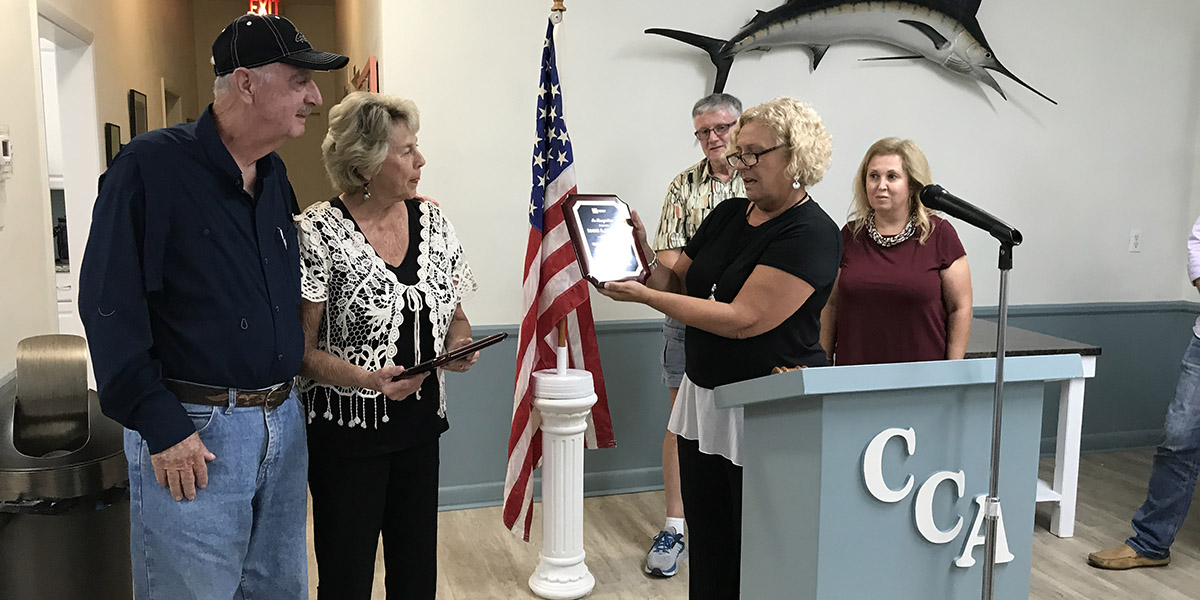THE HISTORY OF THE ISLES OF CAPRI
As told by Rosanna Loach, Wife of Leland L. “Doc” Loach
The Isles of Capri was once a series of Mangrove islands rising from the waters bounded by the Marco River and Tarpon Bay to the south, Johnson Bay to the west and Mcllvane Bay to the north and is an integral part of Florida’s Ten Thousand Islands. These islands, part of Florida, had served under four different foreign flags before being acquired by the United States in 1821, under a treaty with Spain. In 1845, Florida was admitted into the Union by an Act of Congress and, in July 1923, Collier County was carved from a portion of Lee County and named for BARRON GIFT COLLIER, the man who owned most of the real estate in the county and was responsible for this Legislative action.
For about a hundred years after Florida was admitted to the Union, the Isles of Capri area slumbered along, sometimes changing ownership, but with no development taking place and few changes in its topography. The only known resident of the Isles prior to 1956 was a “Mr. Hudson”. He lived a hermit’s life in a little shack on what is now Dolphin Circle. Although he never became famous, and evidently had no desire to, his daughter was Estelle Taylor, a very popular movie actress who was married to the world-renowned boxer Jack Dempsey It is very likely there were other residents from time to time, as the history of the whole Ten Thousand Islands abound with talks of pirates, buried treasure, rum-running and solitary men wanted by the law. These state of affairs, however, was due for a change, and the history of the Isles of Capri was about to start in June 1955 through the foresight of “Doc” Loach.
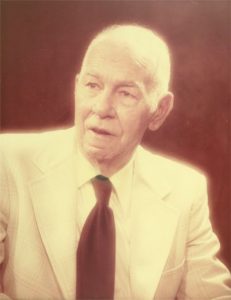
Doc Loach
Leland L. “Doc” Loach was born in Dunlop, Tennessee on September 7, 1907, one of five sons of William and Ellen Loach. Doc spent his formative years in LaFayette, Georgia where the elder Loaches owned and operated the local pharmacy. It was here, at the tender age of 13, that “Doc” undertook his First enterprising venture, a plumbing business, which he owned and operated himself. Later on, he studied at Palmer School of Chiropractic, in Des Moines, Iowa where he first obtained the nickname “Doc”, by which he was to be known and loved for the rest of his life.
“Doc” entered the U.S. Navy and after his tour of duty, returned to his home state to attend Georgia Tech. In 1945 he moved to Fort Lauderdale to find his paradise in the sun, only to realize that this imagined Utopia was not geared to fit the average man’s wallet. One night, while eating dinner in a local restaurant, he overheard a conversation in progress at an adjoining table.
The men were saying that one day the entire strip from Miami to Fort Lauderdale would become one continuous string of cities. Since “Doc” was seeking an engaging enterprise he decided, then and there, that it would be real estate. He then scoured the Fort Lauderdale area to locate a suitable site. With no experience whatsoever to guide him in this venture, he proceeded to purchase, ten acres at a time, of what finally became 275 acres on the outskirts of the city. He decided to call it Chula Vista.
Chula is the Indian word for “pretty” and Vista a Spanish word meaning “view” thus, “pretty view”. “Doc” researched his project thoroughly, seeking information at the local library on real-estate development. He consulted closely with Cecil Farrington, a respected attorney, and Mrs. Otis (Ann) Smith, who was well versed in the mechanics of land transfers and abstracts.
He questioned engineers, bankers, county and state officials. In twelve months, “Doc’s” idea flowered into a community of some ninety families, all lined by a common goal, to own their own homes. Canals were dug, seawalls installed, streets paved, sidewalks and street lights were put in place, a community hall and church built All the conveniences needed for a good lifestyle were afforded the people who believed in “Doc” and purchased land at $14.00 down SI0.00 per month, trading labor with their neighbors in order to complete their homes.
In 1947, “Doc” took time from his activities to take a wife, one Rosanna Rowland, a native of Pennsylvania, who came to Florida to continue her profession of nursing. They began their married life in Chula Vista and a daughter, Rosemary was born to them in 1949.
By 1955 Chula Vista had become a viable community and “Doc’s” work was done so he was anxious to move on. One day Rosanna and “Doc” drove to Stewart to fish. The weather was blustery and worsened as they drove north. At “Doc’s” suggestion, they drove to the west coast. From the time they arrived in Fort Myers they followed every road leading towards the Gulf of Mexico.
Following the old Tamiami Trail, they made their way to Royal Palm Hammock, towards the fishing village that was then Marco, crossing the old swinging bridge near Good! Arriving at Marco, they decided to check out the fishing, so they took a room at the Old Marco Lodge, then owned by Marge and Alex Tasetano. There was just one room available with a private bath and they felt fortunate to get it. The next morning, following an excellent breakfast served by Marge Tasetano, they fished from Kelly Gant’s dock. “Doc” was pensive – and sent Rosanna to seek information regarding available lots.
Rosanna’s queries went unanswered. The Islanders guarded their privacy well and newcomers to the island were not welcome before the Mackle Brothers purchased the Collier holdings on Marco and encouraged new residents.
The following morning, they decided to go to Naples to purchase a new bait bucket that they had forgotten to take along. While Rosanna was making the purchase, “Doc” went into the real estate office of Benson, Pulling and Jones to see what real estate was available. The salesman, George Buser, showed him a map indicating a group of fourteen islands. “Doc” immediately recognized the location as that being on the Marco River.
Mr. Buser could not put a price on the land since one of the owners, State Representative David Jones, was in Tallahassee on business. However, he assured “Doc” that he would be in touch with him. Three weeks later, “Doc” received a letter advising him that there were six hundred acres in the group of mangrove islands, carrying a price of $350 per acre. That same day “Doc” was in the Benson office and a contract for the purchase was consummated. Thus, the seed for the Isles of Capri was planted.
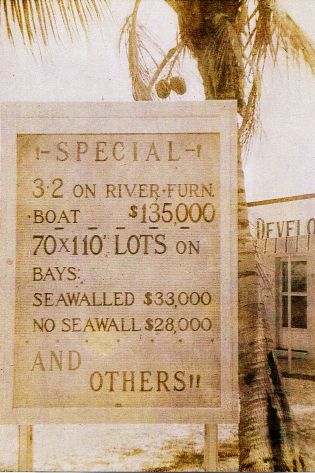
"For Sale" Sign
This was to be a very unique development, fashioning a viable community out of dense mangrove swampland. But “Doc” had a vision – to create a place where man and nature could live in harmony. If he gave thought to the vast array of problems that would provoke him, it was outweighed by his enthusiasm to complete his dream. “Doc” returned to Marco to set up his operation, and rented the one facility he could find, from Elva and Grist Griffith, an office with a dirt floor for $100 per month. He would be working from there until he could build his own office on the Isles of Capri. He also purchased two wooden boats with outboard motors and rented dock space on Marco.
From that point on, prospective clients were ferried across the Marco River to view prospective sites. “Doc” then engaged Mr. M.E. Gerry, his engineer at the Chula Vista project, to work with him on the Isles of Capri. Needless to say, Mr. Berry did not share “Doc’s” enthusiasm in this new venture, as they sloughed through the mangroves with mosquitoes, sand flies and chiggers biting at them, but— “Doc’s” enthusiasm prevailed, and the job was soon underway. It was 1956 when work began to carve the Isles of Capri out of this wilderness. The first major project was to conduct an aerial survey to work on maps and plats could proceed. Consultations with a number of very important people was necessary to ensure that every step of progress conformed to and was approved by state and local officials, the Internal Improvement Board and the U.S. Corps of Engineers. Before the dredge could start up its engine, $5,000 had to be paid to the State for a permit to fill the land. A bulkhead had to be birthed to retain the fill that was pumped and a charge of 5 cents per yard had to be paid to the State.
Bill Harris, a dredge captain from Fort Lauderdale, was hired to bring in his equipment to do the pumping. Enroute to Naples the dredge sank in Lake Okeechobee and on Christmas Eve, “Doc” had to leave his family and help recover this vital equipment from its watery grave. Finally, the dredge was delivered and put into service. About six months later “Doc’s” accountant discovered that Harris had been overpaid by $20,000. Harris was having financial difficulties and could not repay the indebtedness. Against the advice of his attorney and banker, “Doc” bought the dredge from Harris and hired his own crew to operate it. His next darkest day was when his expert mechanic was returned to the mental institution from which he had escaped. The First plans included a ferry between Marco and the Isles.
The necessary official approval was received, the ferry purchased and delivered, and the ferry captain was about to embark on the maiden voyage, but at the last minute, the whole enterprise was blocked by Marco. Many people on Marco, at that time, did not want to see any further development of the area. For five years, twenty hours a day, the dredge pumped. “Doc” lost many hours of sleep due to the dredge breaking down during the night. On Island #1 all the trees and undergrowth were pushed over and buried. On Islands #2 and #3 and the business island, the debris was pushed over and burned before it was covered with fill. Sand, silt and marl was pumped in to connect the four main islands and the roadbeds were filled to 5 feet above sea level. The engineer felt that 5′ would be adequate, but “Doc” insisted upon the higher figure, that later proved to be a very wise decision. In 1960, when hurricane Donna passes over the area with torrential rain and winds to 175mph, the Isles of Capri suffered no damage from rising water.
About this time “Doc” realized he was not getting the amount of fill, he should be getting, for the number of hours the dredge worked. One day, while sitting at his desk in his Marco office, he picked up a pair of binoculars that had been a gift from his brother-in-law and saw two of his workers axing holes in the huge spill pipe that had been special ordered, for the project, from Texas. “Doc” jumped into his little boat that was pushed by a small outboard motor and went out to the dredge. He said, “you boys come back to the office with me, I want to talk to you.” Before departing he had told his comptroller to have their checks made out by the time he got back because he anticipated trouble. Back at the office they were given their final checks and fired. He then hired another crew from Marco who proved to be quite satisfactory.
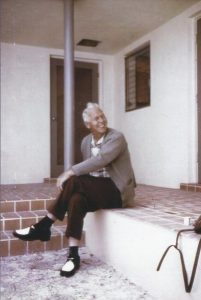
Doc's First House
Aggravations continued to dog the project but nothing too great for “Doc” to handle, so he never did lose interest. After Island #1 was filled he built the first home on the Isles of Capri and moved his wife and daughter in. This home was located on the Marco River where at the time waterfront property was selling for $5,000 per lot including bulkhead and seawall. “Doc” knew all too well that with the interest generated in his project, and current and future sales of lots, he had to give serious thought to getting better accessibility to the Isles of Capri. The drive from Naples to Marco via Route 92 was a long and arduous one, and this was a matter that had to be solved as soon as possible. “Doc” petitioned the Board of County Commissioners, then in Everglades, who at the time were A.C. Hancock, J. Janes, Dewey Policy, Dick Goodlette and Wes Downing. They voted to grant him permission to pump in a causeway across Mcllvane Bay.
About that time Julius “Junkie” Fleischmann purchased the acreage to the north of the Isles and agreed to pay $11,000 for the fill needed for the causeway since it would make his land more accessible. Now with a permit in hand “Doc” went into action and work began, but again, not without problems and delays. The first was to raise a dragline and bulldozer that both sank in the bay during transportation. The roadbed was finally completed and shell, from a nearby shell mound, was hauled in to stabilize the sand, however, the shell created a problem of its own. It caused a driving hazard by puncturing car tires. With the basic shell road complete, it was time for “Doc” to establish his office on Capri, so he built an office and moved his secretary, June Nash, a local girl from Marco, over to Capri and for the first time felt settled in. He still had a problem with the access road so once again “Doc” went back to the County Commission and worked out a plan in which the county would pave the road and “Doc” would bear the burden of about $35,000, for the grass seed and fertilizer, to complete breams on both sides or the seven miles of road which then became known as the Isles of Capri Road or State Road #951. It proved to be an excellent arrangement. The Isles of Capri now had a first-class roadway to the outside world and much later on, when the first high-rise bridge to Marco was built, it provided that Island with far better access to the Tamiami Trail. Although sales of land were not great, they were moving along to “Doc’s” satisfaction He knew it was just a matter of time before sales would pick up.
One of the first purchasers describes her initial visit like this lower my spirits sank. When we turned off Route 41 and rattled over a few bridges, I knew genuine despair. When we got out here, we found a dredge at work at one end of the island and the bulldozer scraping mangroves off the other end. The only promising thing I could see was “Doc’s” enthusiasm and optimism. As he extolled the wonders to come, I couldn’t see any of them, but my husband could see all of them. It was a case of love at first sight with him. We bought a lot that very day. We both signed the papers in a state of shock – mine from dread (will I ever have to live in this isolation?) – my husbands from elation – he’s found Utopia. Happily, I’ve changed my first impression; and also, happily, my husband never has. He’s still living in Utopia”.
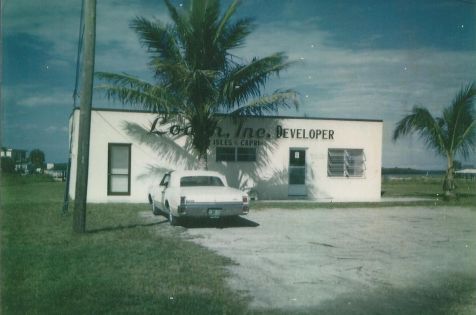
Doc Loach’s Office
The next basic requirement “Doc” had to meet was to provide potable water for a community that was in its early stages of development. At the outset, the water system consisted of a 45,000-gallon reservoir that was filled with water hauled in twice daily from Naples. It was then distributed from the reservoir to the residents. This proved to be a very expensive and impractical solution, so it became necessary to find a potable well field to meet the needs of future residents. In an effort to solve the problem “Doc” must have drilled 175 to 200 test wells searching for a good supply of fresh potable water. Then one morning a carpenter who was working for “Doc” failed to show up for work, so he went out to check on the man. He noticed the man had a well in his yard with a hand pump. He tasted the water found it was fresh, so he put a sample of it in a sanitary vial, that he carried for this purpose, and had the Naples Water Department to analyze it. They reported that it was fine water. “Doc” determined that the land along the old grade called Manatee Road belonged to the Collier Company. Working through Norman Herren he was able to secure permission to use this field.
Before a water plant could be built the proper permit procedure had to be followed. “Doc” was issued a permit with the understanding that the County could take over the facility any time they saw fit. In conjunction with the property owners on Capri and other interested parties, “Doc” formed a joint venture, called Capri Water Works Inc. Shares were issued at a cost of $450.00 each and “Doc” personally provided the corporation with a non-interest-bearing loan. With this money, service lines and meters were installed, and the plant constructed. The Isles of Capri Waterworks operated the utility from 1963 until 1981 when finally, the County concluded an agreement for the purchase of the utility.
When “Doc” first moved to the island he ferried his daughter, Rosemary, across the river to the Tommy Barfield School on Marco. This required two trips a day. As additional families moved to the island, a more feasible solution had to be found. The School Board refused to accept responsibility for busing students from the Isles of Capri so “Doc” paid a woman, Mrs. Ruth Mitchell, to drive the children up to the Tamiami Trail, where the school bus picked them up. He paid her salary, as well as all the necessary insurance and other expenses for her car. All this with the full knowledge that he was paying as much in school taxes as anyone else in the county. He decided to rectify this situation and obtain the same services for his community as others in the county enjoyed. So again, he went to the School Board, but it was not until a lawsuit was filed against the Collier County School Board and the State of Florida, that a school bus was made available.
Telephone lines made their way to the Isles, but not without a hassle. The phone company wanted $22,000 to put through six telephone lines to connect the islands to the mainland. “Doc” threatened to install his own telephone system before he would pay such an exorbitant fee but finally a compromise was reached with “Doc” paying just $2,200.
Florida Power and Light, however, was far more cooperative, helping in every way possible by installing poles and lines for electricity and by providing very satisfactory service. House to house mail delivery was not an easy service to obtain. At first, the mailboxes were placed on Route 951, near the Tamiami Trail. The hazards of vandalism made it necessary to move them to an area near the water storage tanks.
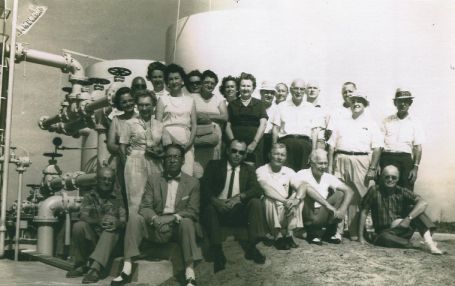
Original Shareholders
In 1968 street signs and house numbers were provided and house-to-house mail delivery became a reality. The mailman also delivered the daily newspaper, first at one business establishment and then another. At first, the residents would go down to pick up a paper and at the same time, pass the time of day with their neighbors. Later on, however, both the mail and newspapers are delivered to one’s door.
When the Isles of Capri was in its infancy, in order to cast one’s vote, a trip to Marco, via the old Goodland Bridge, was necessary. Finally, in 1963, when there were 23 registered voters, the Isles of Capri was given its own Precinct No. 2. “Doc’s” own voting card was #4158, which shows the number of registered voters in the county at the time.
Now voting is carried on in the Community Center. Precinct #2 leads the county in voter turnout, achieving an enviable 100% several times. As the population continued to grow other services gradually became available. There are several business institutions on the island that include four fine restaurants, several marinas, TV cable service, and most important a firehouse. The property on which the firehouse stands was donated by “Doc”. There is also ambulance service furnished by the county. Just as “Doc” was about to breathe a sigh of relief at having surmounted ail his problems and having reached the point in a development where a man can begin to look back at his accomplishments, fate’s hand dealt the crudest blow. “Doc” became a victim of Parkinson’s disease, which would keep him from experiencing the true exhilaration of success. But the groundwork he laid had a firm foundation.
The community was growing and vibrant. The citizens joined group activities, which eventually became the Isles of Capri Civic Association. When meetings could no longer be held in private homes, a community building was erected. It still stands today and is used for many purposes: community dinners, youth activities, exercise and art classes, bridge games and up until the time the Capri Christian Church was built, church meetings were held there. “Doc” passed away in August of 1987 having accomplished his dream – his place in the sun – in spite of so many setbacks that, no doubt, would have discouraged a man of lesser character and determination.
He was indeed, a very special person. The Isles of Capri now has four marinas, four waterfront restaurants with boat slips; the firehouse was rebuilt and is now manned by full- time paid personnel complemented with volunteers and a county furnished “Advanced Life Support” ambulance.
In addition, for voting purposes, our Community Center is now Precinct 642. Also, the community in conjunction with Rookery Bay is about to embark on a massive project restore the natural water flow in Tarpon Bay.

Doc Loach

"For Sale" Sign

Doc's First House

Doc Loach’s Office

Original Shareholders
